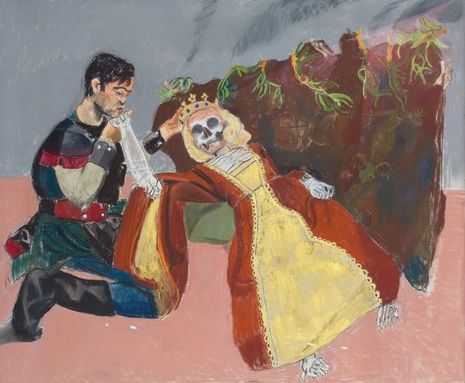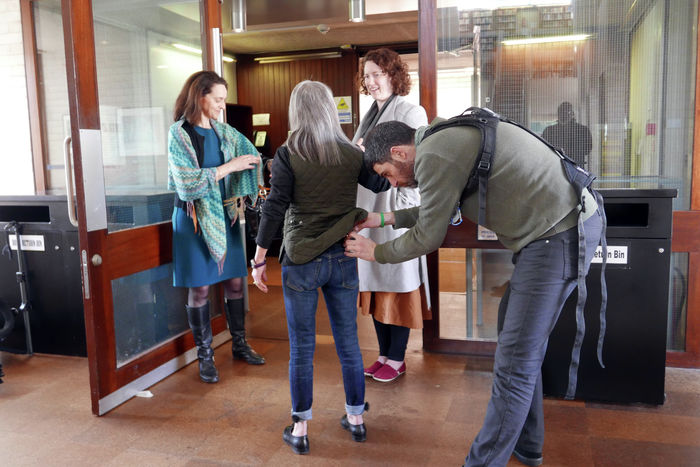Understanding the legacy of Dame Paula Rego
Arts Editor Esmé Kenney discusses the life and work of Dame Paula Rego, and the relevance of her art in today’s climate

Content Note: This article contains discussion of abortion and violence against women
When walking into the Dome at Murray Edwards college, one of the most noticeable artworks is Inês De Castro, painted by the late Dame Paula Rego. The painting depicts the skeleton of the dead queen, dressed in finery and wearing a crown, whilst her King kneels beside her and kisses her hand. Though commissioned by the college, the painting contains many of the elements typically present in Rego’s work, such as femininity, violence, and folk themes from her native Portugal. Her works maintain pride of place in the Women’s Art Collection, but their reach extends far beyond the college grounds.
“Reality and mythology are uncomfortably welded together, creating pieces that disturb and unsettle the viewer”
Born in Portugal in 1935, Rego decided to become an artist when she was 8, and was later sent to England for finishing school. She went on to become one of Britain’s most successful artists, exhibiting with the London group alongside David Hockney and becoming the first ever Associate Artist of the National Gallery in London. As her artwork reveals, Rego was not only concerned with politics and violence (particularly concerning women), but also folklore and myth. Real issues, such as women’s rights and particularly abortion, are often portrayed through the prism of folk tales. Reality and mythology are uncomfortably welded together, creating pieces that disturb and unsettle, rather than cushioning or providing an escape from the issues at hand.
The more folklore-heavy side to Rego’s work is reflected in Inês De Castro (2014), which is based on a famous Portuguese folk tale. According to myth, Prince Pedro was deeply in love with Inês, (his former wife’s lady-in-waiting) but because she was perceived as a threat to the line of succession, the King had her killed. In a bout of revenge, the prince took the crown from his father, and ripped out the hearts of the assassins. What happened next was even more horrifying: Pedro dug up Inês’ corpse, gave it a grand procession, and according to later adaptations of the story, the corpse was even given its own coronation ceremony. It is this image of the delusional King, dressing up the rotting corpse of his dead lover and proclaiming her Queen, that Rego captures masterfully. On the surface, Inês could be viewed as a puppet for Pedro’s emotional outbursts, lacking any agency of her own.
“Given the recent attempts to roll back reproductive rights, Rego’s work seems more poignant than ever”
Other works by Rego, such as her famous Dog Women pastel drawings, engage more directly with contemporary political and social issues. In Dog Woman (1994), she asked her model Lila Nunes, (who nursed Rego’s husband) to crouch down, open her mouth wide, and generally behave like a dog. Other paintings in the series, such as Bride (1994), represent women in a less animalistic way, but they are nonetheless ‘Dog Women’, according to Rego. She argued that women, like dogs, are trained to be submissive, but are ultimately still part animal. Rather than being portrayed as the obedient, feminine ideal, the women in this series use their bodies to show their independence, and that they are in Rego’s words, “not downtrodden but powerful.”
This idea of women being empowered despite their suffering is also present in Rego’s representations of abortion. Rego was particularly vocal about the issue, and was open about having had abortions herself. In response to the 1998 referendum in Portugal, which proposed liberalising abortion laws, she produced a harrowing series of paintings, which depict women sat in the immediate aftermath of having had an illegal abortion. The women appear worn, ashamed, but still defiant; in Rego’s words, “[t]hey are not pictures of victims.” Though unable to influence the referendum result, these paintings are thought to have swayed public opinion, leading to a second referendum in 2007, when the law was changed.
“A superficial viewing would suggest that she depicted women as powerless, but this was never her intention”
Given the recent attempts to roll back reproductive rights in the US, Rego’s work seems more poignant than ever. In an interview with The Guardian in 2019, following the growth of the anti-abortion movement, she said it was “unbelievable” that these battles had to be fought again, and said that the criminalisation of abortion would “forc[e] women to the backstreet solution.” Although she did not live to see the Supreme Court’s decision to overturn Roe v. Wade, she was clearly affected by the possibility of these rights being revoked in the US, especially given her role in the Portuguese pro-choice movement.
Following Rego’s death in June, the director of the Tate Maria Balshaw said that she “uniquely revolutionised the way in which women’s lives and stories are represented.” A superficial viewing of Rego’s work suggests that she depicted women as powerless, but this was never her intention. Another way of interpreting Inês De Castro is to view the queen as powerful, instead of passive. The King, having wreaked havoc on his Kingdom because of her death, kneels before her in a display of submission. Even in death, she is dressed in red and gold, sprawled in the centre of the frame. As curator of the Women’s Art Collection Naomi Polonsky highlights, “[s]he dominates the composition even though she’s a corpse.”
It is through this subversion of existing hierarchies that Rego’s work, and indeed the feminist messages that it carries, will remain relevant in years to come. At a time when women’s rights across the world are in a state of flux, and the once “unbelievable” becomes reality, Rego’s work continues to confront us with shocking and gruesome truths, whilst using folklore to invoke our most primal and visceral fears.
 News / CUP announces funding scheme for under-represented academics19 December 2025
News / CUP announces funding scheme for under-represented academics19 December 2025 News / SU reluctantly registers controversial women’s soc18 December 2025
News / SU reluctantly registers controversial women’s soc18 December 2025 News / Cambridge welcomes UK rejoining the Erasmus scheme20 December 2025
News / Cambridge welcomes UK rejoining the Erasmus scheme20 December 2025 Features / Should I stay or should I go? Cambridge students and alumni reflect on how their memories stay with them15 December 2025
Features / Should I stay or should I go? Cambridge students and alumni reflect on how their memories stay with them15 December 2025 Film & TV / Timothée Chalamet and the era-fication of film marketing21 December 2025
Film & TV / Timothée Chalamet and the era-fication of film marketing21 December 2025










